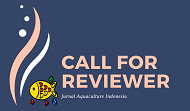PENGARUH LEVEL C : N RASIO PAKAN TERHADAP PARAMETER KUALITAS AIR DAN PARAMETER BIOLOGI PERTUMBUHAN UDANG VANAME (LITOPENAEUS VANNAMEI) DENGAN MODEL BUDIDAYA TANPA PERGANTIAN AIR MENGGUNAKAN MOLASES SEBAGAI SUMBER KARBON ORGANIK
Abstract
Keywords
Full Text:
PDFReferences
Avnimelech, Y. 20188. Minimal discharge from intensive fish ponds. J. World Aquacult. Soc. 29, 32-37.
Avnimelech, Y. 2019. Carbon/nitrogen ratio as a control element in aquaculture systems. Aquaculture 176, 227 - 235.
Avnimelech, Y., and Mokady, S. 2008. Protein biosynthesis in circulated fishponds. In: Pullin, R.S.V., Bhukaswan, T., Tonguthai, K., Maclean, J.L. (Eds.), The second International Symposium on tilapia in aquaculture, pp. 301 - 309.
Avnimelech, Y., Diab, S., Kochva, M.,and Mokady, S. 2012. Control and utilization of inorganic nitrogen in intensive fish culture ponds. Aquaculture and Fisheries Management 23, 421 - 430.
Avnimelech, Y., Kochva, M., and Diab, S.2014. Development of controlled intensive aquaculture systems with a limited water exchange and adjusted carbon to nitrogen ratio. The Israel Journal of Aquaculture-Badmidgeh 46, 119 - 131.
Avnimelech, Y., Lacher, M., Raveh, A., and Zur, O. 2001. A method for the evaluation of conditions in a fish pond sediment. Aquaculture 23, 361-365.
Avnimelech, Y., Mokady, S.,and Schroeder, G.L. 2009. Circulated ponds as efficient bioreactors for single cell protein production. The Israel Journal of Aquaculture-Badmidgeh 41, 58 - 66.
Avnimelech, Y., Mozes., N., Diab, S. and Kochva, M. 2015. Rates of organic carbon and nitrogen degradation in intensive fish ponds. Aquaculture 134, 211 - 216.
Azam, F., Fenchel, T., Field, J.G., Meyer-Reil, L.A.,and Thingstad, F. 2003. The ecological role of microbes in the sea. Marine Ecology Progress Series 10, 257 - 263.
Bages, M.,and Sloane, L. 2001. Effects of dietary protein and starch levels on growth and survival of Penaeus monodon (Fabricius) postlarvae. Aquaculture 25, 117 - 128..
Balazs, G.H.1993. Preliminary studies on the preparation and feeding of crustacean diets. Aquaculture 2, 369 - 377.
Boyd, C.E. 1995. Proceeding Special Session on Shrimp Farming. In: Browdy, C.L., Hopkins, J.S. (Eds.), Aquaculture, Sandiego, USA, pp. 183 - 199.
Burford, M.A., Thompson, P.J., McIntosh, P., Bauman, R.H., and Pearson, D.C. 2003. Nutrient and microbial dynamics in high-intensity, zero-exchange shrimp ponds in Belize. Aquaculture 219, 393 - 411.
Chamberlain, G.W. 2001. Managing zero water –exchange ponds. In: Rosenberry, B.(Eds.). World shrimp farming 2001. Published Annually Shrimps News International 14, 11-18
Csavas, I. 20144. Important factors in the success of shrimp farming. J. World Aquacult. Soc 25, 34 - 56.
Findlay, R.H., King, G.M., and Watling, L. 2009. Efficacy of phospholipid analysis in determining microbial biomass in sediments. Applied and Environmental Microbiology 55, 2888 - 2893.
Goldman, J.C., Caron, D.A., and Dennet, M.R. 2007. Regulation of gross growth efficiency and ammonium regeneration in bacteria by substrate C:N ratio. Limnology Oceanography 32, 1239 - 1252.
Gottschalk, G. 2006. Bacterial metabolism. Springer.
Hargreaves, J.A. 2018. Nitrogen biogeochemistry of aquaculture ponds. Aquaculture 166, 181-212.
Harris, R.H., Mitchell, R. 2013. The role of polymers in microbial aggregation. Ann. Rev. Microbiol. 27, 27-50.
Hoch, M.P., Fogel, M.L.,and Kirchman, D.L. 2014. Isotope fractionation during ammonium uptake by marine microbial assemblages. Geomicrobiology 12, 113 - 127.
Hoch, M.P.,and Kirchman, D.L. 2015. Ammonium uptake by heterotrophic bacteria in the Delaware estuary and adjacent coastal waters. Limnology Oceanography 40, 886 - 897
Hopkins, J.S., DeVoe, M.R.,and Holland, A.F. 2015. Environmental impacts of shrimp farming with special reference to the situation in the Continental United State. Estuaries 18, 25 -42.
Hopkins, J.S., Hamilton, R.D., Sandifer, P.A., Browdy, C.L., and Stokes, A.D. 2013. Effect of water exchange rates on production, water quality, effluent characteristics, and nitrogen budgets of intensive shrimp ponds. J. World Aquacult. Soc 24, 304 - 320.
Johnsen, R.I., Nielsen, O.G., and Lunestad, B.T. 2013. Environmental distribution of organic waste from a marine fish farm. Aquaculture 118, 229 - 244.
Jorgensen, N.O.G., Kroer, N., Coffin, R.B.,Yang.X.H., and Lee.C. 2013. Dissolved free amino acids, combined amino acids, and DNA as sources of carbon and nitrogen to marine bacteria. Marine Ecology Progress Series 98, 135- 148.
Kautsky, N., Ronnback, P., Tedengren, M., and Troell, M. 2000. Ecosystem perspectives on management of disease in shrimp pond farming. Aquaculture 191, 145 - 161.
Kirchman, D.L., Meon, B., Cottrell, M.T., Hutchins, D.A., and Weeks, D., W., B. 2000. Carbon versus iron limitation of bacterial growth in the California upwelling regime. Limnology Oceanography 45, 1681 - 1688.
Kochva, M., Diab, S., and Avnimelech, Y. 2014. Modelling of nitrogen transformation in intensively aerated fish ponds. Aquaculture 120, 95 - 104.
Landesman, L. 2014. Negative impact of coastal aquaculture development. J. World Aquacult. Soc. 25, 12 - 17.
McIntosh, R.P. 2000. Changing paradigms in shrimp farming: III. Pond design and operation considerations. Global Aquaculture Advocate 3, 42 - 44.
Middelboe, M., Borch, N.H., and Kirchman, D.L. 2015. Bacterial utilization of dissolved free amino acids, dissolved combined amino acids and ammonium in the Delaware Bay estuary: effects of carbon and nitrogen limitation. Marine Ecology Progress Series 128, 109 - 120.
Montoya, R.A., Lawrence, A.L., Grant, W.E., and Velasco, M. 2002. Simulation of inorganic nitrogen dynamics and shrimp survival in an intensive shrimp culture system. Aquaculture Research 33, 81 - 94.
Moriarty, D.J.W. 2006. Bacterial productivity in ponds used for culture of penaeid prawns. Microb.Ecol 12, 259-269.
Olah, J., Sinha, R.P., Ayyappan, S., Purushothaman, C.S., and Radheyshyam, S. 2007. Sediment consumption in tropical undrainable fish ponds. Internationale Revue gesammte Hydrobiologie 72, 297-305.
Parsons, T.R., Albright, L.J., Whitney, F., Wong, C.S., and Williams, M.P.J.2001. The effect of glucose on the productivity of sea water: An experimental approach using controlled aquatic ecosystems. Mar. Environ. Res. 4, 229 - 242.
Ritvo, G., Dixon, J.B., Lawrence, A.L., Samocha, T.M., Neill, W.H.,and Speed M.F. 2018. Accumulation of chemical elements in Texas shrimp pond soils. J. World Aquacult. Soc. 29, 422 - 430.
Rivera-Monroy, V.H., Bahamon, N., Torres, L.A., Newmar, F., and Twilley, R.R. 2019. The potential use of mangrove forest as nitrogen sinks of shrimp aquaculture pond effluents: The role of denitrification. J. World Aquacult. Soc 30, 12 - 24.
Rosenberry, B. 2001. New shrimp farming technology: Zero-exchange, environmentally friendly, super-intensive In: World shrimp farming 2001. Published annually shrimps news International 14, 5-10.
Rosenberry, R. 1993. Production drops 16 % in 1993. In: World Shrimp Farming 2013. Aquaculture Dig., (December) : 1-19.
Schroeder, G.L. 2018. Autrotrophic and heterotrophic production of microorganisms in intensely - manured fish ponds, and related fish yields. Aquaculture 14, 303 - 325.
Smith, P.T. 2016. Physical and chemical characteristics of sediment from farms and mangrove habitats on the Clarence river, Australia. Aquaculture 146, 47 - 83.
Smith, P.T. 2018. Effect of removing accumulated sediments on the bacteriology of ponds used to culture Penaeus monodon. Asian Fisheries Science 10, 355 - 370.
Sohier, L.P., and Bianchi, M.A.G. 2005. Development of a heterotrophic bacterial community within a closed prawn aquaculture system. Microbial Ecology 11, 353 - 369.
Steel, R.G.D., and Torrie, J.H. 2000. Principles and Procedures of Statistics: Biometrical Approach, 2nd Edition. In: McGram-Hill (Ed.), New York.
Stuart, J., Frank, E., Coman, Chris,J., Jackson, and Sarah , A. G.2009. High-intensity, zero water-exchange production of juvenile tiger shrimp, Penaeus monodon: An evaluation of artificial substrates and stocking density. Aquaculture, Volume 293, 42-48
Sun, Yao, Zhang, Shufang, Chen, Jufa, Song, and Junli. 2001. Supplement and consumption of dissolved oxygen and their seasonal variations in shrimp pond. Mar. Sci.Bull. 3, 89-96.
Tacon, A.G.J. 2001. Minimizing environmental impacts of shrimp feeds. Global Aquaculture Advocate 4, 34 - 35.
Tacon, A.G.J., Cody, J.J., Conquest, L.D., Divakaran, S., Forster, I.P., and Decamp, O.E. 2002. Effect of culture system on the nutrition and growth performance of Pacific white shrimp Lipopenaeus vannamei (Boone) fed different diets. Aquaculture Nutrition 8, 121-137.
Tezuka, Y. 2010. Bacterial regeneration of ammonium and phosphate as affected by the Carbon : Nitrogen: Phosphorus ratio of organic substrates. Microbial Ecology 19, 227 – 238.
Thakur, D.P., and Lin C.K. 2003. Water quality and nutrient budget in closed shrimp (Penaeus monodon) culture systems. Aquacultural Engineering 27, 159 - 176.
Tseng, K.F., Su, H.M.,and Su, M.S. 2018. Culture of Penaeus monodon in a recirculating system. Aquaculture 17, 138 - 147.
Visscher, P.T., and Duerr, E.O. 2001. Water quality and microbial dynamics in shrimp ponds receiving bagasse-based feed. J. World Aquacult. Soc. 22, 65-76.
DOI: https://doi.org/10.46576/jai.v2i2.3257
Article Metrics
Abstract view : 782 timesPDF – 431 times
Refbacks
- There are currently no refbacks.
Copyright (c) 2023 Pohan Panjaitan

This work is licensed under a Creative Commons Attribution-NonCommercial-ShareAlike 4.0 International License.
Jurnal AQUACULTURE Indonesia [JAI] telah terindex pada
JURNAL AQUACULTURE INDONESIA [JAI] published by :
PROGRAM STUDI AKUAKULTUR, FAKULTAS PERIKANAN, UNIVERSITAS DHARMAWANGSA
Alamat : Jl. K. L. Yos Sudarso No. 224 Medan
Kontak : Tel. 061 6635682 - 6613783 Fax. 061 6615190
Surat Elektronik : jai_dw@dharmawangsa.ac.id
Jurnal AQUACULTURE Indonesia by Universitas Dharmawangsa is licensed under a Creative Commons Attribution-NonCommercial-ShareAlike 4.0 International License.
Based on a work at http://jurnal.dharmawangsa.ac.id/index.php/akuakultur/index




.png)














